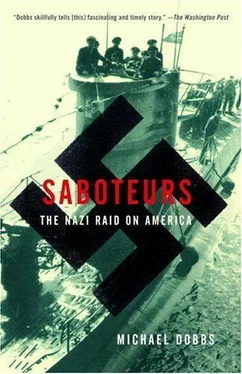At the end of a dive, the whole submarine was “as quiet as a church,” Dasch noted. 13Nobody said a word. The slightest sound might give them away.
• • •
BY THE fourth day out of Lorient, the saboteurs had settled into the routine of life aboard U-202. Even as it traveled westward, through several time zones, the ship stuck religiously to Berlin time, as did the entire U-BOAT fleet. 14Wake-up time was at 6 a.m., followed by breakfast at 6:30 and ship cleaning at 7. The main meal was at 12 noon, and there was a light supper at 5:15 p.m. The day was divided into six four-hour watches; the watch officers and lookouts were each responsible for two watches over a twenty-four-hour period.
Once the ship was out in the ocean and the risk of being spotted by enemy planes had receded, it traveled mainly on the surface. “Submersible” might be a better term than “submarine” for a Type VII-C German U-boat such as U-202, which was only capable of traveling relatively short distances underwater. It needed to come to the surface frequently in order to recharge its electric batteries and make more rapid progress. At the average underwater speed of two knots, it would have taken nearly two months to cross the Atlantic.
Although surface travel was faster, it was also much more uncomfortable. The ship was tossed about on the ocean, and battered by the winds and the waves. The crew was accustomed to these conditions, and reported calm weather throughout the trip. But the four saboteurs felt wretched and spent most of their time in their bunks, trapped in a seemingly endless roller-coaster ride. With the exception of Heinck, who had worked as a seaman as a young man, the saboteurs got violently seasick. 15
The most seasick of all was Dasch, a poor seaman, whose most fervent wish was “to get this thing over.” He kept asking Linder and the other officers if they could make the ship go a “little faster,” only to be told that ten knots was the optimum speed for fuel consumption. In theory, the 750-ton ship could make up to eighteen knots, but that was reserved for an emergency.
Type VII-C boats like U-202 were considered the “workhorses” of the German submarine fleet. 16Dönitz favored them because they were extremely maneuverable and had quick diving times and a low silhouette, meaning they were difficult for the enemy to spot. They could be refueled at sea from larger submarines, enabling them to make return trips across the Atlantic, and were small enough to be mass-produced. Of the U-boats commissioned during the war, nearly half were VII-Cs, a slightly more sophisticated variant of the original Type VII.
Although Linder gave the V-men freedom to move around his ship, with the exception of the radio room and its top-secret Enigma machine, Burger found it “impossible to walk around very much because of the fact that the boat was fully manned.” 17The gangways were crammed with food supplies, including hard-crusted black bread, cheese, potatoes, various kinds of sausage, noodles, and large cans of coffee. On long voyages, the crewmen would first eat their way through the fresh food and then open the cans. When someone needed to move about the ship, he would have to alert the rest of the crew to maintain a proper trim, particularly underwater. Phrases like “man going aft” or “man going forward” were constantly echoing through the ship. 18
By the third or fourth day out, the entire boat, plus the ship’s company, had started to stink. The smell was a mixture of burning diesel oil, human sweat, cooked food, and the cheap perfume that the men used to disguise the other unpleasant odors. There was barely enough fresh water to drink, let alone to wash. The entire company shared two toilets: one for officers and senior petty officers, and another for other members of the crew. As guests, the saboteurs were permitted to use the officers’ toilet.
Soon, Linder and his crewmen were sporting mustaches and full beards. They wore the same clothes every day, in Linder’s case a slate-blue leather coat and pants that became ever more grimy and stained as the trip progressed. As captain, Linder wore a white cap, to distinguish himself from the rest of the crew, who wore blue caps.
Despite the difficulties of moving around, Dasch eventually explored the entire ship, beginning in the forward torpedo room, where a total of ten torpedoes were stored: four in the tubes, ready to fire, and another six among the bunks and hammocks and in the bilges. This area was so jam-packed with men and gear that some submariners called it “the cave.” 19The missiles aboard U-202 were a mixture of air-propelled torpedoes and electric torpedoes powered by battery, the latest in German marine technology. The crew used an ingenious pulley system to lift the torpedoes from the bilges and ram them into place. “Just take a look at how wonderfully the torpedoes are stored away,” the torpedo officer boasted to Dasch. “Our enemies often wonder how a little submarine can carry this many torpedoes.” 20
The next compartment aft was the chief petty officers’ quarters, where Dasch and Burger had two upper bunks. This compartment also contained the captain’s quarters, screened by a curtain to give him some privacy, and the radio room, where the Enigma codebooks were kept under lock and key in steel drawers. The control room occupied the center of the ship, underneath the conning tower, and was packed with “a million gadgets” that indicated speed, depth, balance, and revolutions per minute of the engine. There were numerous other dials and valves, most of which were meaningless to the V-men but had a vital role to play in the operation of the ship. When the boat was a few feet below the surface, the captain could also use the periscope in the control room to scan the horizon for the enemy and order torpedo attacks.
The petty officers’ quarters, where Quirin and Heinck were bunked, was the next compartment aft. This compartment was alongside the galley, where a young round-faced Swabian boy from southern Germany named Otto Wagner prepared meals for the entire crew on three small electric plates and a tiny oven, in a space that measured 59 inches by 27.5 inches. As cook, Wagner was known as Smutje, a special nickname that reflected his vital contribution to shipboard morale. He served up meals on collapsible wooden tables in the aisle, which had to be dismantled whenever someone was moving through. Despite the lack of culinary resources, the saboteurs agreed that the food on board U-202 was “exceptionally good,” much better than regular army meals. 21
The last two compartments aft were the domain of the chief engineer, the second-most-important man on the ship after the captain, and housed the diesel and electric engines, as well as most of the electrical equipment. The chief engineer was responsible for the smooth technical functioning of the submarine, leaving the captain free to concentrate on waging war. There was always something that needed fixing; during the first few days of the voyage, the ship was plagued by rudder problems. 22While the main rudder was out of operation, the chief engineer rigged up a hand rudder. The stern of the ship also contained another torpedo tube, plus a spare torpedo, but these were rarely used.
The saboteurs were occasionally allowed to join the officer of the watch on the bridge for fresh air and a cigarette. During one of these smoking breaks, Dasch noticed a three-foot-long metal plate shaped like a porcupine hanging from the conning tower, alongside the ship’s official name, the Innsbruck. He was told that the porcupine was the ship’s unofficial emblem, tolerated by the navy as a way of promoting a fighting spirit among the crew.
Dasch was so taken by the emblem that he asked the chief engineer to stamp out eight miniature porcupines, similar to those worn by crew members on their caps as good luck charms. 23The other saboteurs had been showing signs of frustration with his leadership, and he wanted to make things up to them. He distributed two of the little porcupines to each saboteur, saying they would come in handy as a secret communication system in America. If one member of the team wanted to send a message to a comrade, he would give the intermediary a porcupine to identify himself, and the recipient would know that “the man is all right.”
Читать дальше












